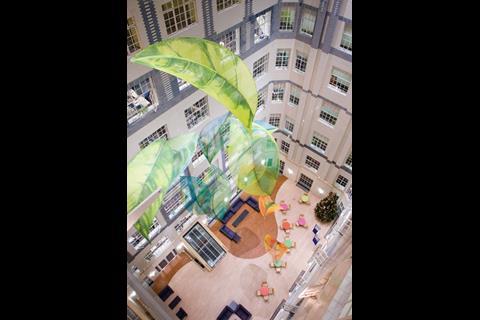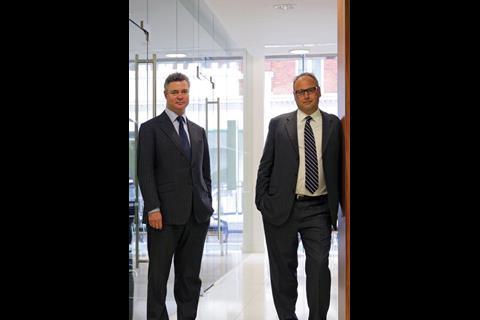Both Chris Booth and Anthony Brown from Overbury have one aim in mind: to deliver in a fast and complex market. Here, they tell Pamela Buxton how they intend to do it
Offices have never had to work so hard. It’s no longer enough to be supremely flexible, efficient and packed with all the appropriate technology. Today’s office also has to be a desirable place to work that’s capable of attracting and retaining staff. Plus, there’s the growing pressure to deliver offices super-fast, and in as cost-effective and, more recently, sustainable a way as possible. All this is what makes fit-out such a challenging and enjoyable sector, according to Overbury managing director Chris Booth (CB) and Anthony Brown (AB), sales and marketing director.
What is fit-out?
CB: When people think of fit-out, they often imagine a huge, expensive, high-spec glass law firm’s office but it’s not all like that. There’s a really interesting mix of work in terms of type of client and value. In fact two-thirds of Overbury projects are under £1m in value so we’re not hung up on the big stuff. We put the same amount of effort into projects for smaller businesses, and they will have ongoing needs too. Fundamentally, that’s what we’re interested in – a long term relationship.
Sometimes there’s a misconception that fit-out is easy – putting up a few partitions and giving the space a lick of paint, but it’s much more complex than that. You have to work closely with the design and consultant team to ensure that everything is co-ordinated, programmed and delivered within the specified design, timeframe and budget. With technological advances and clients’ expectations of having more complex projects delivered faster then ever before, it’s about using your experience and knowledge to build intelligently.
But we’ve been around for a while now and have delivered over 50 million ft2 of offices in the last 10 years, so we have plenty of experience to draw upon.
AB: That’s right. Overbury employs over 400 staff, 30% of whom have been with the company for more than 10 years, so we’re old hands at this now. We’ve probably worked with most of the consultants and architects in our market at some point, so we have a very close working relationship with a lot of them and that helps when you’re working at pace. Nowadays, the process moves so fast that often projects go on site with only a partial design in place – this presents a real challenge and requires true collaboration from all involved.
What drives the fit-out market?
There’s a misconception that fit-out is easy – a lick of paint, a few partitions. It isn’t
Chris Booth
CB: The market is driven by change – leases, which create an ongoing churn, and of course economic cycles. In the last few years the office market has grown at an enormous rate, and the downturn also creates need for churn and change.
The skills shortage has also created a need for businesses to appeal more to employees, hence the growth of facilities like high-quality restaurants, gyms and social areas.
AB: New trends in market sectors can also cause a ripple effect through a specific industry. For example, if one law firm decides to go open plan and finds it encourages communication, helps recruit top-quality graduates and improves productivity, then others will follow suit.
Environment and sustainability have also affected change, whether it is driven by government legislation, pressure from shareholders or simply because occupiers are buying into the long-term benefits of energy-efficient buildings.
Is there a growing regional market?
CB: Traditionally, the fit-out market wasn’t as well defined in the regions but that’s now changed. There’s little or no difference in specification and far more emphasis on design.
AB: Office markets have changed considerably, with Snowhill in Birmingham and Spinningfields in Manchester being good examples of how things have moved on. You now have high-quality offices in the regions and they need a fit-out that can offer a comparable quality. Better transport links and infrastructure in cities like Manchester, Birmingham, Bristol, Leeds and in Scotland have resulted in the attraction of large corporates to the regions. And with the significant cost savings that can be made on rents, greater investment can be made on providing a really fantastic working environment for their employees.
The process moves so fast projects often go on site with only a partial design in place
Anthony Brown
What are the key changes taking place in fit-out?
CB: It’s getting a lot faster. Technology’s had a huge impact on expectations. People want an instant response – we now have webcams on site for meetings with international clients or for clients to keep track of how a project is running in real time. Technology has enabled all this, such as the new project management software we’ve rolled out across our sites that allows fast distribution of drawings, instructions and constant communication across the team.
AB: Sustainability is really driving change in terms of innovation and the development of new technologies in fit-out – innovations such as rainwater harvesting, photovoltaics, CO2 cooling systems and combined heat and power units are now being recognised as not only good for the environment but cost-effective too.
CB: Flexibility will be a big challenge going forward. Because rents are a significant overhead, people are thinking more carefully about how they use their space.
AB: A bank can move up to 80% of its people around in one year, and they want to be able to do that themselves, so we have to take that into consideration when we are configuring the M&E and make any systems as flexible as possible. Also, things like formal meeting rooms are disappearing – offices are becoming more like clubs, even law firms. That’s definitely a trend.
What do you think makes Overbury distinct?
CB: Specialist knowledge of what we build, whether it be for lawyers, petrochemical offices, the public sector or banks. We’re not re-inventing the wheel every time – we have a lot of past experience to draw from and clients and consultant teams like that. Expectations are much higher than they used to be. We are brought on board much earlier on in the process now and are expected to be proactive, help problem-solve and come up with solutions to challenges rather than just pointing out what can’t be done. Our track record of delivering projects without snags means clients get into fully operational space exactly when they planned to, without disruption to their business.
Two-thirds of Overbury’s projects are under £1m – we’re not hung up on big stuff
Chris Booth
How is Overbury able to deal with today’s financial instability?
CB: We’re part of Morgan Sindall. We have a strong balance sheet, very good assets and we’re not dependent on borrowing. We also have an excellent supply chain with fair ways of working. Our Dun & Bradstreet rating is very high – we probably have the best credit rating in our industry. It’s a very sound, well-run business.
We’ve also got a well-balanced spread of work across the public sector and commercial world. We have very good coverage in the UK, with offices in London, Bracknell [in Berkshire], Manchester and Birmingham so we can offer clients a truly national service now.
What impact has the desire for sustainability had on the way you work?
AB: Delivering a carbon-neutral or sustainable project is much in demand. It’s not that hard to achieve if you think about it upfront. We’ve invested a lot of time and effort on waste management, recycling on site, and streamlining our deliveries where possible. Most recently we’ve been working to develop a standardised model for calculating and monitoring the carbon footprint of our fit-out projects. This allows us to offer clients a seamless service, from tracking and monitoring vehicle movements and energy use, to providing details of the embodied energy in materials brought to site.
CB: The £25m fit-out we completed for Defra at Nobel House (pictured) was the first commercial office project in the UK to achieve a BREAAM “excellent” rating. We made the fit-out as sustainable as possible.
What do you enjoy most about the work?
AB: The most exciting thing is the diversity – one day it might be a cutting-edge new media firm and the next a very traditional occupier.
CB: The pace of what we do is so fast – 350 projects per year. The most exciting thing is working with the client, being involved with them and getting right into their world. That’s the buzz. We learn a lot from them – that’s the wonderful thing about fit-out.
Inside Story 2008
- 1
- 2
 Currently reading
Currently readingOn your marks
- 3
- 4
- 5
- 6
- 7
- 8
- 9































No comments yet